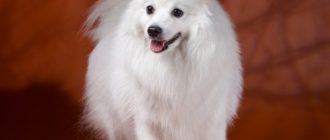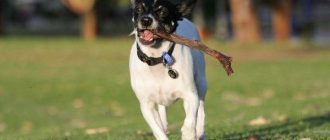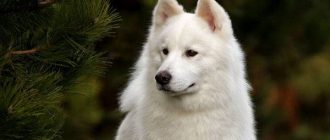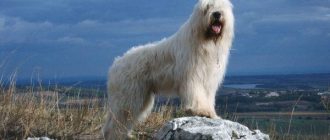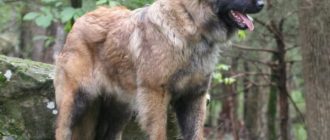Assessment of breed characteristics
Contents
| Adaptability Definition of how easy a dog is. can adapt to changes in life. |  |
| Shedding Level Level and frequency of hair loss in animal. |  |
| Level of tenderness Level and amount of tenderness and affection that the dog gives back in return for attention to itself. |  |
| Need for Exercise Daily Activity Level dogs. |  |
| Social need Required number of dog contacts with other animals as well as people. |  |
| Housing ratio Factor that determines the level of noise and other inconvenience that the dog can deliver to the owners in the ratio apartment size to dog size. |  |
| Grooming Number of bathing, combing, as well as necessary number of professional grooming sessions required the dog. |  |
| Friendliness in an unfamiliar environment society with strangers or in an unfamiliar environment. |  |
| The tendency to bark The tendency to bark and its frequency and volume. |  |
| Health Issues Potential Health Status dogs. |  |
| Territorial tendency of the dog to protect his house, yard or even a car owner. |  |
| Cat friendliness A trend towards cat tolerance and reduced manifestation of hunting instincts. |  |
| Intelligence Dog’s ability to think and solve emerging difficulties (not to be confused with learning!). |  |
| Education and training Level of difficulty in training a dog perform certain actions. |  |
| Friendliness for children Factor determining how much the dog friendly to children, whether she likes to play with them and endure some children’s pranks. |  |
| Game activity The concept is determined by its very name, and, usually found in almost all dogs. |  |
| Observing Dog’s ability to detect presence a stranger in his territory. |  |
| Friendliness for other dogs Dog’s tendency to find common language with other relatives. |  |
Brief description of the breed
Schnauzers – the common name for the three breeds of dogs whose homeland considered Germany. Schnauzers are distinguished by size: miniature schnauzer, Mittelschnauzer, Giant Schnauzer. In appearance, the listed breeds absolutely similar, while their growth is from 30 cm to 70 cm, their weight ranges from 4-8 kg to 35-47 kg. The smallest indicators at the miniature schnauzers (miniature schnauzers), and the largest at Giant Schnauzers (large schnauzers). Schnauzers are dogs medium size, their height is about 50 cm, weight is about 17 kg. Schnauzers of all sizes are distinguished by a thick and tough coat, elongated on the face in the area of the beard and eyebrows. Giant Schnauzers and the middling schnauzers perform well as service dogs, and the miniature schnauzers, due to their small size, mostly play the role of pets, living in an apartment. All three breeds differ only in size, and addition, as well as character traits they are similar. All schnauzers are distinguished by an elongated head, blunt muzzle, flat forehead, semi-erect ears (which may be stopped), oval eyes of dark color, neck muscular, without hanging, square torso, limbs straight, strong, wide enough set, tail has a saber form. Schnauzer hair is stiff with developed undercoat, on eyebrows (eyes should not be completely hidden by flowing hair) and the beard is always elongated. Wool color – black (for miniature schnauzers sometimes with white markings in the muzzle, chest, and inside abdomen, near the anus), pepper and salt (dark gray undercoat and relatively light gray wool), also miniature schnauzers there is a white shade of wool.
Schnauzer photo:
Photo of Schnauzer dogs |
Origin history
The homeland of the Schnauzers is the southern part of Germany – Bavaria. Mention of dogs in appearance similar to modern schnauzers appeared in the 18th century, however, talk of schnauzers as a breed then it didn’t. A couple of centuries ago, these animals were called pinschers. (from the English “pincher” – “capture, clamp”), presumably thanks to their strong teeth. Moreover, the pinschers had different colors wool (black, brown, white, gray, yellowish with tan and marks), their wool itself could be both short and long, hard or soft. Pincher growth in the 18th century was about 30-40 cm. In a word, there was no talk of a breed as such, they were medium sized dogs with certain traits – endurance, mobility, courage. Most popular over time began to conquer wire-haired pinschers with a long wool on the face, which began to be called by the middle of the 19th century schnauzers (from the German “schnauze” – “face” and “schnauzbart” – “beard, mustache”). They were famous for their ability to catch mice and rats, helped in cattle grazing, guarded the owners’ housing from the enemy. Schnauzers were bred by long selection work small, medium and large. To create the breed were used in Germany wire-haired pinschers, as well as Wolfspitz, pugs, dachshunds, bulldogs, poodles and other dogs.
Schnauzer character
Schnauzers of all sizes are very smart and wayward, they definitely requires a strong and fairly tough owner as dogs such breeds sometimes try to dominate the soft-hearted and allowing any master pranks. Schnauzers are active and playful (especially at an early age). They are excellent watchmen, with distrust of new people. With proper education tolerate other animals, get along well with family members the owner. Schnauzers, whose upbringing was not given due attention, can be quite vindictive and naughty, but here the owner’s fault, rather than the dogs. Experienced breeders and dog handlers call schnauzers “dogs with human intelligence” – so they are smart, obedient, able to calculate the current situation right up to to the smallest detail thanks to excellent instinct and developed intuition.
Maintenance and care
Schnauzers and Giant Schnauzers can live in an apartment and in the yard (in the presence of an aviary and insulated kennel). BUT miniature schnauzers, because of their small size, most often settle in apartments. In any case, the dog should have its own place where there is a bed, bowls for water and food, toys. Schnauzers need daily active exercise, especially when live in an apartment, not having the opportunity to run around in the open. But even dogs living in private or suburban homes need daily walk at least once a day for at least an hour. For them active pursuits on walkways or outdoors (in the forest, park, etc.). Those dogs that do not have the ability daily physical activity, over time they become aggressive, irritable, lack of walks affects and on metabolism (obesity) .Rough schnauzers do not fade independently, therefore, the owner should from an early age accustom the puppy to trimming to save the animal from dead hairs. Trimming allows the schnauzer to get new hair, relieves tartans, has beneficial effects on skin and wool integument. Schnauzers should be combed regularly, preferably each day (or at least several times a week). Bathing dogs is better Carry out as it is contaminated, but not more often 2-3 times a year. For washing Schnauzer is advisable to purchase a special shampoo for wire-haired dogs. Washing paws after a walk, combing, attention to the condition of the eyes, tracking the hair on the face after eating, examining and brushing your ears and teeth – these are simple moments when the execution of which the dog has a neat, well-groomed appearance. Schnauzers can be both natural and industrial. Often Schnauzer owners prefer premium dry feed and Super premium quality for active dogs. Not worth it anyway treat the animal with such dishes: sweet, fatty, spicy – in a word, all that for four-legged and not intended.
Training and training
Schnauzer puppies must be subjected to early socialization, which will consist not so much in training teams as in getting used to life in the family and society. Owner from the start must show the dog that its supporting role, that is, even the little puppy must be aware that the owner is not a toy, not his servant. You shouldn’t shout rudely at the kid, you shouldn’t beat, but in the process of education, when the schnauzer puppy shows aggression, bites, spoils the furniture or personal belongings of the owner, you can strictly talk to the animal or (in extreme cases) lightly push twig for croup. To the process of getting used to a new family and everyday life was successful, it’s good to introduce elements of the game into the puppy’s education, not while allowing the little schnauzer to cross the line of what is permitted. These dogs can be easily and quickly trained when it interesting. Of whom of the schnauzers no matter what they are, all of them are both tsverg and Mittels and Riesens require training. If the dog starts in as a home guard and family friend, it’s nice to take a general course training. In some cases, schnauzers can successfully pass classes on protective and guard duty. Training these dogs is better entrust to specialists in cases where the owner plans to schnauzers show future, while domestic dogs are not applying for high ranks can be successfully trained in teams and obedience by the master on his own.
Health and Disease
Schnauzers are not dogs with poor health, they are often cross the 15-year frontier of life. But these robusts have characteristic disease that may in the absence of the correct treatment turn into trouble: dysplasia (most often hip joints) is a congenital disease in which improper joint development. Diabetes mellitus is a disease caused by a malfunction of the pancreas (low production insulin). Hypothyroidism – a disease caused by failure thyroid hormones. Pancreatitis – inflammation of the tissues and violation of the patency of the pancreatic ducts. Epilepsy – a disease caused by damage to brain cells and the nervous system. Eye diseases (cataract, glaucoma, etc.). Dermatitis – inflammation dermis, an allergic reaction to any irritant. Inversion stomach – mechanical obstruction or reflex spasm the stomach. Oncological diseases (lipoma, melanoma).

